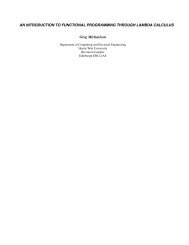A Probability Distribution and Its Uses in Fitting Data
A Probability Distribution and Its Uses in Fitting Data
A Probability Distribution and Its Uses in Fitting Data
Create successful ePaper yourself
Turn your PDF publications into a flip-book with our unique Google optimized e-Paper software.
208RAMBERG, TADIKAMALLA, DUDEWICZ AND MYKYTKAalso be calculated. For a specified frequency histogramthis requires the solution of (2) for p at each ofthe <strong>in</strong>terval endpo<strong>in</strong>ts. This is straightforward numerically,s<strong>in</strong>ce R(p) is a well-behaved <strong>in</strong>creas<strong>in</strong>gfunction of p. Alternatively, <strong>in</strong>tervals can be determ<strong>in</strong>edus<strong>in</strong>g the estimated percentile function withspecified (perhaps equal) probabilities. Then one simplycounts the number of observations fall<strong>in</strong>g <strong>in</strong> each<strong>in</strong>terval <strong>and</strong> computes the approximate X2 statistic <strong>in</strong>the usual manner. (See, for example, p. 302 of [6].)One might wish to use some criterion other thanmoments for estimat<strong>in</strong>g the parameters. For example,nonl<strong>in</strong>ear least squares can be used to obta<strong>in</strong>the values of the parameters which m<strong>in</strong>imize thesquared distance between the percentile function (2)<strong>and</strong> the empirical percentile function.4. TABLE CONSTRUCTION AND ACCURACYTable 4 gives the values of X,, XA, X3 <strong>and</strong> A4 correspond<strong>in</strong>gto values of a3 <strong>and</strong> a4 with zero mean <strong>and</strong>unit variance. (A shorter prelim<strong>in</strong>ary version of Table4 appeared <strong>in</strong> [3].) The lambda values are given for a3rang<strong>in</strong>g from 0.0 <strong>and</strong> 0.90 <strong>in</strong> steps of 0.05 <strong>and</strong> from0.90 to 2.0 <strong>in</strong> steps of 0.1. For each a3, lambda valuesare given for 39 values of a4 <strong>in</strong> steps of 0.2, exceptwhere SA <strong>and</strong> X4 are near zero <strong>and</strong> are given <strong>in</strong> steps of0.1, start<strong>in</strong>g from the lower limit <strong>in</strong>dicated <strong>in</strong> Figure3. The grid of a3 <strong>and</strong> a4 values is sufficiently f<strong>in</strong>e sothat <strong>in</strong>terpolation is generally unnecessary. (The densityplots of adjacent entries <strong>in</strong> the table will differonly slightly, even though the lambda values maydiffer substantially.)The values of Table 4 have been rounded to fourdecimal digits, except where <strong>in</strong>dicated by a plus sign(+) or a dollar sign ($). The plus sign (+) <strong>in</strong>dicatesthat the parameter value has two lead<strong>in</strong>g zeroes <strong>and</strong>consequently has been rounded to six decimal digits<strong>and</strong> multiplied by 100. Similarly, those values <strong>in</strong>dexedby a dollar sign ($) have four lead<strong>in</strong>g zeroes<strong>and</strong> have been rounded to eight digits <strong>and</strong> multipliedby 10,000. This was done to provide as many significantdigits as possible <strong>in</strong> order to enhance the accuracyof the tabled value. Tabled values marked by aplus sign (+) should thus be multiplied by 10-2 <strong>and</strong>those marked by a dollar sign ($) should be multipliedby 10-4.The vast majority of the tabled values yield differencesbetween the calculated <strong>and</strong> specified values ofa3 <strong>and</strong> a4 of less than 0.01, i.e. |la(X3, A4) - ajl 1.0. The values of XA<strong>and</strong> X2 were checked <strong>in</strong> a similar fashion <strong>and</strong> yielded amean with<strong>in</strong> 0.01 of zero <strong>and</strong> a variance with<strong>in</strong> 0.01of one. These values result from closed form calculations<strong>and</strong> can be calculated by the user exactly.TECHNOMETRICS ?, VOL. 21, NO. 2, MAY 1979For specified values of a3 <strong>and</strong> a4, the 3, <strong>and</strong> A4values were orig<strong>in</strong>ally computed by Tadikamalla [15]by solv<strong>in</strong>g the nonl<strong>in</strong>ear equationsa3(A3, A4) = a3a4(X3, A4) = a4,us<strong>in</strong>g the subrout<strong>in</strong>e ZSYSTM <strong>in</strong> the IMSL system(available from International Mathematical & StatisticalLibraries, GNB Bldg., 7500 Bellaire, Houston,TX 77036). The expressions for a3(X3, X4) <strong>and</strong> a4(X3,A4) were obta<strong>in</strong>ed from equations (4) <strong>and</strong> (5).The table given here is an extended <strong>and</strong> correctedversion of Tadikamalla's. New values were obta<strong>in</strong>edus<strong>in</strong>g the Nelder-Mead simplex procedure for functionm<strong>in</strong>imization where the objective functionf(A3, X4) = (a3(A3, A4) - a3)2 + (a4(X3, X4) - a4)2was m<strong>in</strong>imized over A3 <strong>and</strong> X4, subject to the constra<strong>in</strong>tthat X3X4 > 0, which <strong>in</strong>sures that X3 <strong>and</strong> X4 areof the same sign. (See Olsson <strong>and</strong> Nelson [8] for adiscussion <strong>and</strong> applications of the Nelder-Mead simplexprocedure.)Solutions other than those given <strong>in</strong> the table mayexist for certa<strong>in</strong> values of a3 <strong>and</strong> a4, usually with X3 >1 <strong>and</strong> X4 > 1, for which the correspond<strong>in</strong>g densityfunctions are truncated.Either of the two procedures just described can beused to obta<strong>in</strong> the lambda parameters correspond<strong>in</strong>gto a3 <strong>and</strong> a4 values not <strong>in</strong> the table.5. NUMERICAL EXAMPLEWe illustrate our method with the follow<strong>in</strong>g datataken from Hahn <strong>and</strong> Shapiro [6]. Measurements ofthe coefficient of friction for a metal were obta<strong>in</strong>ed on250 samples. The result<strong>in</strong>g values are summarized <strong>in</strong>the first two columns of Table 3. Hahn <strong>and</strong> Shapiro[6] give the follow<strong>in</strong>g values for the moments whichwere calculated from the orig<strong>in</strong>al data: x = 0.0345,/m2 = 0.0098, &8 = 0.87 <strong>and</strong> a4 = 4.92. Round<strong>in</strong>g a3<strong>and</strong> a4 to the nearest tabular values (0.85 <strong>and</strong> 4.9respectively), the lambda values from Table 4 are X,= -.413, A2 = .0134, X3 = .004581, X4 = .0102. Thevalues for A, <strong>and</strong> A2 are calculated as<strong>and</strong>i = -.413 (.0098) + .0345 = .0305A2 = .0134/.0098 = 1.3673.Figure 1 shows the relative frequency histogramfor this data <strong>and</strong> the probability density curve correspond<strong>in</strong>gto the above lambda values. The observed<strong>and</strong> expected frequencies are given <strong>in</strong> Table 3. Acomparison of the computed value of x2 (2.04) withthe tabulated x2 values (see Table 3) <strong>in</strong>dicates that the
















